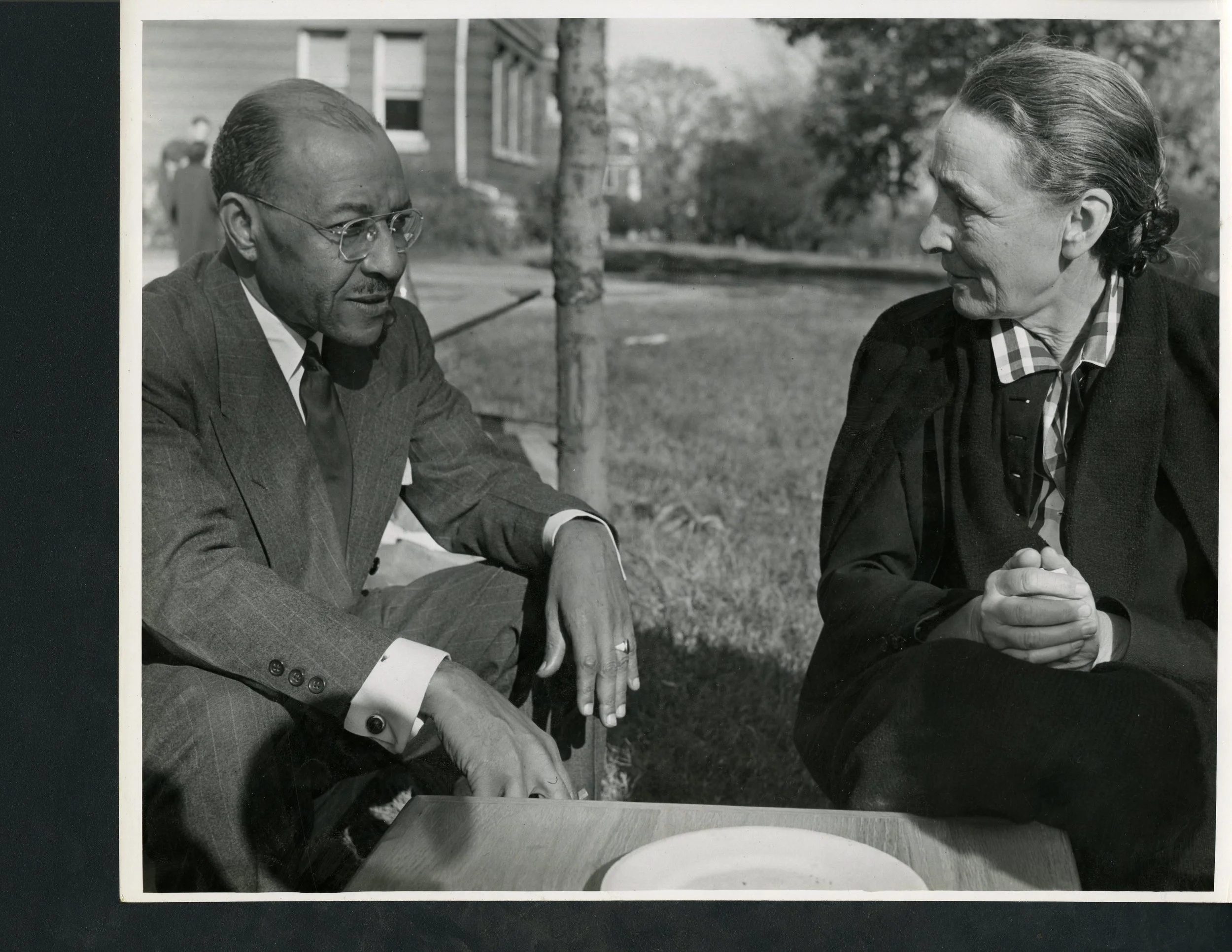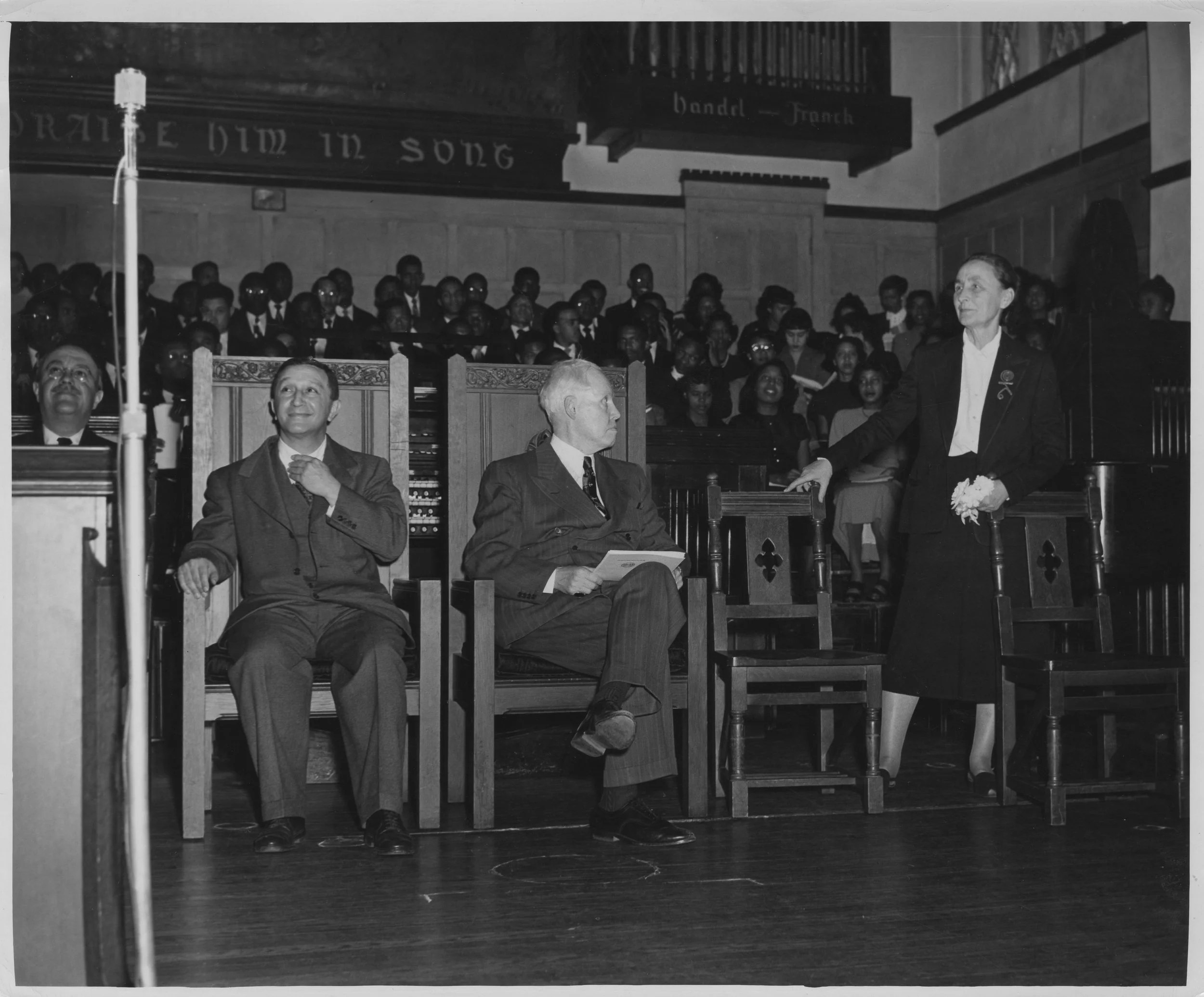Key Figures of the Gallery
-
Born in Topeka, Kansas, Aaron Douglas played a leading role in the Harlem Renaissance of the 1920s and 1930s. Often referred to as the Father of Black American Art, Douglas's artwork reflected his deep commitment to racial justice and the celebration of Black culture and identity. Douglas's distinctive style borrowed elements from African art and modernist abstraction. His iconic paintings and murals capture the strength, resilience, and beauty of the Black experience, often depicting powerful figures and scenes of historical significance. In 1930 Douglas was hired to create a mural for Fisk Universities library. As an alumnus, Douglas's return to his alma mater as an esteemed faculty member brought immeasurable prestige and inspiration to the art department. His groundbreaking work in the Harlem Renaissance, characterized by vibrant colors and rhythmic compositions, not only showcased the rich heritage of African Americans but also challenged prevailing stereotypes and celebrated their resilience. In 1930 Douglas was hired to create a mural for Fisk Universities library. Douglas's influential mural "Aspects of Negro Life," adorning Fisk's walls, served as powerful visual narratives, affirming the importance of Black history and culture within academia. Through his talent, leadership, and commitment, Aaron Douglas transformed Fisk University into a dynamic hub for artistic innovation and cultural enlightenment, leaving an enduring legacy for generations to come.
-
Charles S. Johnson made significant contributions to Fisk University during his tenure as President from 1947 to 1956. Known for his trailblazing work in sociology and his commitment to civil rights, Johnson brought a wealth of knowledge and expertise to the university community. Under his leadership, Fisk University continued to flourish as a center for intellectual and cultural exploration.One of Johnson's major contributions was his emphasis on expanding the university's academic programs. He worked tirelessly to recruit renowned scholars and artists, fostering an environment of intellectual rigor and creativity. Friend of Carl Van Vechten and through Van Vechten he brought the Stieglitz collection to Fisk., as well as Aaron Douglas, and enlisted him to be the chair of the art department. He also founded the race relations Institute at Fisk. and he’s also responsible for the Cyrus Baldridge drawings from his book White Africans and Black.
Johnson's vision for a well-rounded education led to the establishment of new departments and programs, including the development of a pioneering African American studies curriculum. By broadening the academic offerings at Fisk, Johnson ensured that students had access to a wide range of disciplines and ideas, preparing them to become engaged and informed citizens. In addition to his dedication to academics, Johnson was also committed to social justice and activism. He advocated for equal rights and was actively involved in the civil rights movement. Johnson used his position at Fisk University as a platform to engage students in discussions about racial inequality and civil rights issues, inspiring activism both on and off campus. His leadership and unwavering commitment to justice and equality made a lasting impact on the university and its students, shaping the future direction of Fisk as a center for civil rights education and social change.
-
Pearl Saunders Cresswell Class of 1932 an English major at Fisk University. Mother of three children and the first Ambassador of the Fisk University Carl Van Vechten gallery. President Johnson Gave Mrs. Cresswell the responsibility of overseeing the construction, hanging the artworks, and working as a guide for the gallery. When the galleries construction was finished in the late fall of 1949, Mrs. Cresswell worked closely with Georgia O'Keeffe to make sure everything was up to their satisfaction. Making sure every detail was right down to the lighting, the paint color, and how the walls were set up. When opening convocation came around and the number of visitors was not to Mrs. Cresswells liking she did everything to rally people to the gallery. She went to women's clubs and talked at different colleges to bring in more visitors. Pearl Cresswell has made the gallery the staple it is today for the community because of her efforts.
-
Georgia O'Keeffe, born on November 15, 1887, was an iconic American artist known for her distinctive and groundbreaking style. Her innovative approach to painting transformed the art world and established her as one of the most influential figures of the 20th century. O'Keeffe's artworks often depicted enlarged and magnified views of flowers, landscapes, and natural forms, bringing attention to their intricate details and abstract beauty. She was inspired by the natural world, specifically the landscapes of New Mexico, where she spent much of her life. O'Keeffe's use of bold colors and simplified shapes created a sense of intimacy and spirituality in her work. Throughout her career, she challenged societal norms and expectations, paving the way for future generations of women artists. Georgia O'Keeffe's contributions to Fisk University have had a profound impact on the institution and its community. As an influential artist, her visit to Fisk in 1949 sparked a lasting connection between her work and the university's renowned art collection. O'Keeffe's generous donation of her own artwork, alongside her husbands donation of 101 pieces of artwork established the Carl Van Vechten gallery as one of the most important repositories of American art in the nation. Her belief in the power of art education also led her to establish fellowships at Fisk, providing opportunities for students to study and engage with the arts. O'Keeffe's dedication to supporting the arts at Fisk has not only preserved her legacy but has also fostered an environment of artistic excellence and inspiration for generations to come.
-
Stieglitz's association with Fisk University began in the 1930s when he played a critical role in organizing the groundbreaking exhibition titled "Contemporary Negro Art" at his renowned gallery, An American Place. This revolutionary exhibition not only celebrated the artistic achievements of African American artists but also paved the way for meaningful dialogues around race and representation in the art world. Stieglitz's efforts to promote marginalized artists allowed Fisk University to acquire a formidable collection of artworks by leading African American artists, including important pieces by Charles White, Hale Woodruff, and Aaron Douglas. These acquisitions further solidified Fisk University's position as a custodian of African American art, providing a platform for artists of color to be recognized and celebrated.In addition to his role in the acquisition of artworks, Stieglitz's advocacy for the inclusion of African American artists in the broader art world helped elevate Fisk University's reputation as a center for cultural and intellectual exchange. His support and mentorship of young artists, including many associated with Fisk University, created a nurturing environment that fostered the growth and development of African American artistic talent. Inspiring and guiding artists such as James VanDerZee and Jacob Lawrence, Stieglitz empowered them to express their unique perspectives and narratives without compromising their identities. Through his collaborations and contributions, Alfred Stieglitz profoundly impacted the artistic landscape of Fisk University, imbuing its collection with diversity, historical significance, and a commitment to the shared human experience.
-
Carl Van Vechten made significant contributions to Fisk University as a patron and advocate of African American culture. Born in 1880, Van Vechten was deeply captivated by the artistic and intellectual achievements of African Americans during the Harlem Renaissance. Recognizing the immense talent within the community, he dedicated himself to promoting and supporting Black artists, musicians, and writers. One of Van Vechten's most notable contributions to Fisk University was his instrumental role in the acquisition of the Carl Van Vechten Art Gallery in 1949. This gallery became a valuable platform for showcasing the works of African American artists, both established and emerging. Through his vast network and personal connections, Van Vechten brought attention to the wealth of talent present at Fisk and helped cultivate a supportive environment for artistic expression. Moreover, Van Vechten's passion extended beyond the visual arts. He was an advocate for African American musicians, helping to introduce them to larger audiences through his influential book, "Music and Bad Manners." With his writings, Van Vechten aimed to challenge the racist stereotypes prevalent at the time while highlighting the transformative power of African American music. Through his efforts, he exposed a wider audience to the beauty and complexity of African American cultural expressions, which greatly contributed to the recognition and appreciation of Fisk University's rich artistic heritage.







